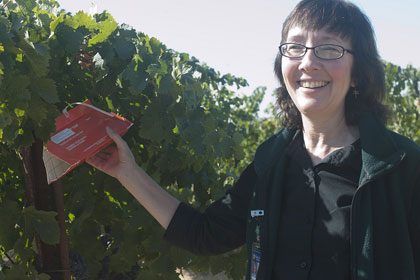Four years ago, Sonoma’s harvest time was clouded by a passionate controversy between local citizens and the agricultural authorities over how or whether to try to eradicate the Light Brown Apple Moth. This small, invasive insect loomed as a threat because it feeds on over 2,000 species of plants, including citrus, fruit trees and grapes.
On one side of the controversy was a vision of California farms devastated by the voracious appetites of this invasive species and on the other, local residential areas poisoned by aerial sprays. After public debate, the California Department of Agriculture (CDFA) decided that the plan for the Sonoma area would be a combination of tracking, inspection, quarantine and local treatment of any infected plants.
The method has worked, but the story is not over.
New threat looms
Today, while measures of prevention and containment remain in place, the LBAM has receded as a topic of concern, a new, more direct threat to the wine industry has emerged – the European Grape Vine Moth (EGVM), which spends most of its life cycle munching on grape clumps.
The EGVM threat, together with controlled threat of the LBAM and the distant if ever-present threat of the Glassy Winged Sharpshooter – whose potential for damage, by spreading Pierce’s Disease, is exponentially greater – means that vigilance continues to be the word of every day for growers, and compliance with the Agriculture Department’s rules must be the word for everyone else.
“Invasive pests are a problem,” said Nick Frey, president of the Sonoma County Winegrape Commission. “They threaten California agriculture in general, and probably our ecology too, so it’s important to try to prevent their import into the state, and if they do get here, to detect them early. If you don’t get early detection, your odds of eradication are low.”
When the EGVM was discovered two years ago, quarantines were immediately imposed and growers were asked to treat infected areas with either organic or conventional insecticides. Other than the expected complaints over the cost of the measures, “Nobody protested,” said Frey.
Harvest time is test time
The real test for the program comes at harvest time, when grapes are being moved from place to place and strict sanitation and transportation precautions underway. Growers in quarantine areas who plan on moving grapes are required to have bins carefully washed, and either “slack-filled [filled only up to about 6” from the top] or tarped for transport.
Red triangular traps can be seen throughout local vineyards, and Ag Commission representatives check them regularly to be sure there are no new “finds.” So far, they say, so good.
Sue Ostrom, Chief Deputy Agricultural Commissioner, attributes the success of the program to the diligence of the growers. “We’re feeling really good,” she said. “The efforts of the industry are what have made this EGVM program pretty successful. There were 59 finds in 2010, and nine finds in 2011, and none so far this year,” she said. “That’s the trend you want to see.” She said the state will do a review at the end of the year and she’s hoping that will result in a “tremendous” reduction in the quarantine boundary.
Citizens are vital to the effort
Viticulture Farm Advisor Rhonda Smith, a field researcher with the U C Cooperative Extension, said it’s important for citizens, too, to understand and comply with the Ag rules, especially when it comes to the temptation to transport plants into Sonoma from other countries or even Southern California, where the Glassy Winged Sharpshooter is well established.
“They’ve never found a GWSS adult in Sonoma,” she said. “But they have found egg masses from nurseries in southern California, which may be located in areas heavily invested with the glassy winged sharpshooter.” Nurseries continue diligent inspection as part of the overall program. “The bottom line is, follow the rules,” said Smith, “because ultimately, the result is pretty dramatic. And who pays the price for that? We pay the price for the enormous effort to eradicate something once it’s here, and/or, we completely lose that industry. We then begin to eat more fruits and vegetables we don’t grow here in California.”






Even if the wasp slows the larger threat of the glassy-winged sharpshooter, local growers will still have to continue to deal with the blue-green sharpshooter, explains Frey.